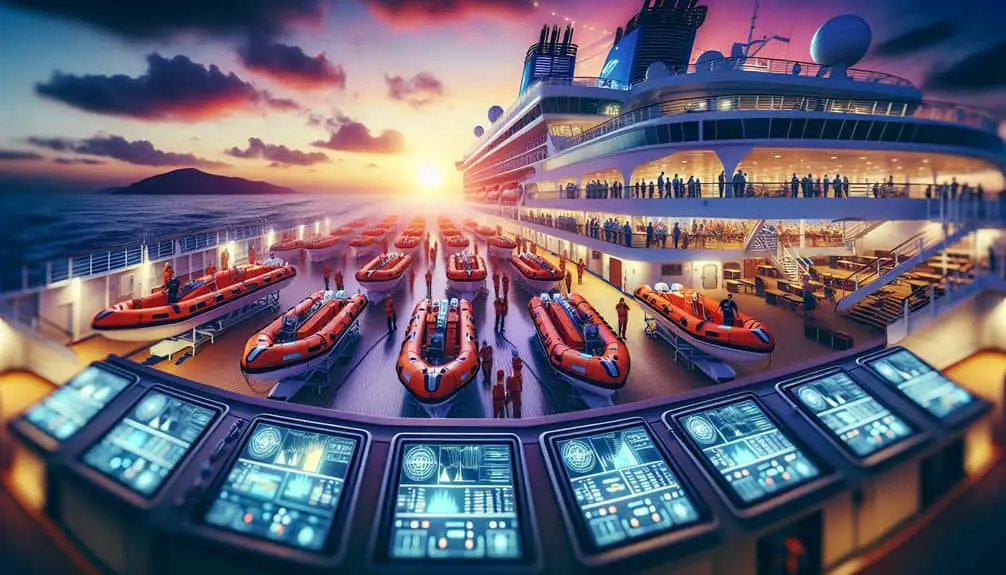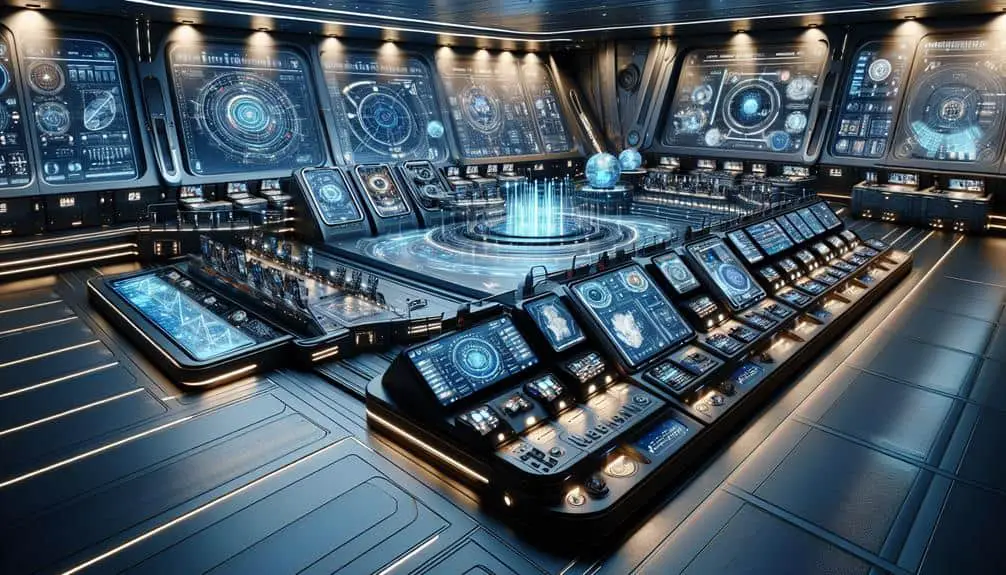Explore advanced fire detection systems, enabling early warning using cutting-edge technology. Enhanced evacuation procedures guarantee swift responses in emergencies with crew training and simulations. Innovative communication technologies provide real-time coordination through remote monitoring and alerts. Rapid medical response solutions offer optimized care with telemedicine services and remote monitoring capabilities. State-of-the-art safety equipment, including drones and smart sensors, enhance monitoring and predictive analytics for crisis prevention. Discover the latest in emergency response systems for cruise ships to prioritize safety and efficiency during emergencies.
Key Points
- Advanced Fire Detection Systems enhance early warning capabilities with intelligent alerts.
- Enhanced Evacuation Procedures include simulations, drills, and crew training for swift response.
- Innovative Communication Technologies ensure real-time coordination and seamless communication during emergencies.
- Rapid Medical Response Solutions optimize onboard emergency care with telemedicine services and remote monitoring.
- State-of-the-Art Safety Equipment like drones, sensors, and predictive analytics enhance response times and safety measures.
Advanced Fire Detection Systems
Upgrade to the latest fire detection systems onboard cruise ships to enhance safety measures and swiftly detect any potential fire hazards. These advanced systems provide a substantial improvement in early warning capabilities by utilizing cutting-edge technology to monitor the ship's environment continuously. Equipped with intelligent alerts, these systems can quickly pinpoint the exact location of a fire outbreak, allowing for immediate response and containment.
By investing in state-of-the-art fire detection systems, cruise ships can greatly reduce the risk of fire-related incidents and enhance passenger safety. These systems utilize a network of sensors strategically placed throughout the vessel to detect even the smallest traces of smoke or heat. Once triggered, the system sends real-time alerts to the ship's crew, enabling them to take swift action and prevent the spread of fire.
Incorporating advanced fire detection systems is essential for ensuring the safety and well-being of everyone onboard. These systems provide a reliable means of early detection, allowing for quick and effective responses to any potential fire hazards. By staying proactive and utilizing the latest technology, cruise ships can create a secure environment for passengers and crew alike.
Enhanced Evacuation Procedures
Enhance onboard safety protocols by implementing advanced evacuation procedures to guarantee swift and efficient response in emergency situations. Evacuation simulations and emergency drills are pivotal in preparing both crew members and passengers for potential crises on a cruise ship.
During evacuation simulations, crew members practice deploying lifeboats, conducting headcounts, and executing evacuation procedures swiftly and accurately. These simulations help identify any weaknesses in the evacuation plan, allowing for adjustments to be made to enhance overall effectiveness.
Emergency drills are conducted regularly to make certain that all individuals on board are familiar with emergency protocols and evacuation routes. Crew members are trained to assist passengers in an organized and efficient manner, prioritizing safety above all else.
Innovative Communication Technologies
Implementing cutting-edge communication technologies on cruise ships guarantees real-time coordination and swift response during emergency situations. Remote monitoring systems play an essential role in continuously tracking various ship functions and environmental parameters. These systems enable crew members to oversee critical areas of the vessel from a centralized location, ensuring that potential issues are identified promptly. Real-time alerts further enhance safety by immediately notifying the crew of any anomalies or emergencies, allowing for rapid assessment and action.
Incorporating advanced communication tools like satellite phones, intercom systems, and emergency notification devices ensures seamless communication between crew members, passengers, and emergency responders. These technologies facilitate efficient coordination during drills, emergencies, and evacuation procedures. Additionally, integrating communication platforms that can transmit data, such as video feeds and sensor readings, aids in decision-making processes and resource allocation.
Rapid Medical Response Solutions
Utilizing state-of-the-art medical response solutions optimizes emergency care on cruise ships, ensuring swift and effective interventions during health crises. Telemedicine services play an important role in providing remote medical assistance to passengers and crew members. Through telemedicine, onboard medical staff can connect with specialized healthcare professionals onshore, enabling real-time consultations and diagnosis. This advanced technology allows for prompt medical advice and treatment recommendations, enhancing the overall efficiency of emergency medical responses at sea.
In addition to telemedicine services, remote monitoring capabilities further bolster the rapid medical response solutions on cruise ships. These capabilities enable continuous tracking of essential signs and health parameters of individuals onboard, facilitating early detection of health issues and proactive interventions. By remotely monitoring passengers and crew members, medical staff can promptly identify and address potential medical emergencies, contributing to a safer and more secure environment on the ship.
State-of-the-Art Safety Equipment
Cutting-edge safety gear onboard cruise ships guarantees the highest level of preparedness for emergency situations. Autonomous drones equipped with advanced cameras and sensors are utilized for real-time monitoring of the ship's surroundings, providing vital information to crew members during emergencies. These drones can swiftly cover large areas of the vessel, aiding in search and rescue operations and evaluating the extent of any potential hazards.
Smart sensors integrated throughout the ship continuously collect data on various environmental factors, machinery performance, and passenger activities. This data is then analyzed using predictive analytics to anticipate and prevent safety issues before they escalate. By detecting anomalies or deviations from normal patterns, these systems alert the crew to take proactive measures promptly.
The seamless integration of autonomous drones, real-time monitoring, smart sensors, and predictive analytics forms a thorough safety net that enhances response times and decision-making during emergencies, ensuring the safety and well-being of passengers and crew on cruise ships.
Frequently Asked Questions
How Often Are Emergency Response Drills Conducted on Cruise Ships to Ensure Crew and Passenger Readiness in Case of an Emergency?
To guarantee readiness for emergencies, cruise ships conduct regular drills. Crew undergo rigorous training to manage emergency responses effectively. Passenger safety is a top priority, with drills scheduled frequently to maintain preparedness and ensure swift, coordinated actions in crisis situations.
Are There Any Specific Protocols in Place for Handling Medical Emergencies That Require Evacuation to a Shore-Based Facility?
In medical emergencies on cruise ships, evacuation procedures are essential for ensuring passenger safety. Specific protocols dictate the process of transferring patients to shore-based facilities efficiently. Regular drills and crew training enhance readiness for such scenarios.
What Measures Are in Place to Protect Passengers and Crew From Potential Biohazards or Infectious Diseases During an Emergency Situation?
In case of biohazards or infectious diseases during an emergency, cruise ships have vital protocols. Crew members are trained rigorously to handle such situations, ensuring passenger safety. These measures are essential for protecting everyone on board.
How Do Cruise Ships Coordinate With Local Authorities and Emergency Services in Different Ports of Call to Ensure a Swift and Effective Response in Case of an Emergency?
In coordinating with local authorities, cruise ships follow strict communication protocols. Response coordination is key, utilizing emergency equipment and local resources effectively. This guarantees a swift and efficient response in emergencies, safeguarding passengers and crew.
Are There Any Specific Training Requirements for Crew Members to Be Certified in Emergency Response Procedures, and How Often Are These Certifications Renewed?
To master emergency response, crew members must meet rigorous training requirements. Certifications must be renewed regularly to guarantee readiness. Your expertise and preparedness are crucial for the safety of all onboard.




